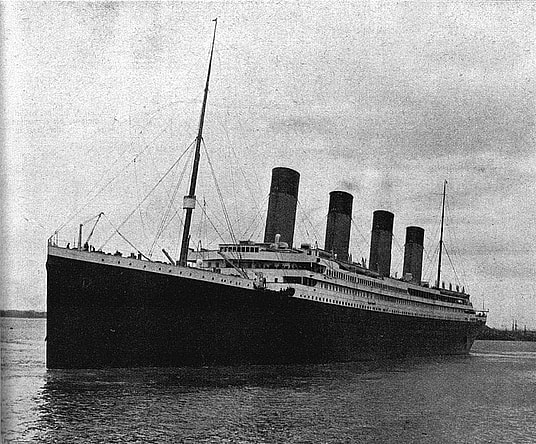
The RMS Titanic, a marvel of early 20th-century engineering and luxury, remains one of the most captivating subjects in maritime history. Launched in 1912, this “Ship of Dreams” promised unparalleled opulence and safety, yet it met a tragic end on its maiden voyage, claiming more than 1,500 lives. The sinking of the Titanic has been immortalized through countless books, films, and documentaries, yet it is the Titanic artifacts of this grand vessel that offer some of the most profound insights into the lives of those aboard. These Titanic artifacts, recovered from the shipwreck site on the ocean floor, bridge the gap between the grandeur of the Titanic and the stark reality of its demise.
All the Titanic artifacts hold a unique story, reflecting the personal experiences, societal norms, and technological advances of the era. From elegant personal belongings to vital pieces of ship equipment, these Titanic artifacts not only enhance our understanding of the Titanic’s final moments but also offer a glimpse into the lives of its passengers and crew. As these Titanic artifacts emerge from the depths of the Atlantic, they bring with them stories of luxury, survival, and tragedy, painting a detailed picture of life aboard one of history’s most famous ships.
In this article, we will delve into ten rare Titanic artifacts, exploring their historical significance and the stories they tell. These Titanic artifacts, ranked from ten to one, are emblematic of the Titanic’s legacy, offering insights into the opulence of its first-class accommodations, the daily lives of its passengers, and the harrowing circumstances of its final hours. Through these objects, we gain a deeper appreciation for the human stories intertwined with the Titanic’s tragic fate, ensuring that the memories of those lost continue to resonate through time.
Read More: 12 Rare Artifacts from Ancient Rome and the Wild Stories Behind Them
10. The Pocket Watch of Benjamin Guggenheim

One of the most hauntingly personal Titanic artifacts recovered from the wreck is the pocket watch of Benjamin Guggenheim. A wealthy American businessman and a prominent passenger, Guggenheim’s story is intertwined with both the opulence and tragedy of the Titanic. The watch, a fine Swiss timepiece made by Longines, was found in the early 20th century among the wreckage and has since become a poignant symbol of the Titanic’s ill-fated voyage.
Benjamin Guggenheim, traveling with his mistress, Madeleine Astor, and his valet, Victor Maire, was a notable figure in the ship’s passenger list. When the Titanic struck the iceberg, Guggenheim reportedly chose to face his fate with dignity. Accounts suggest that he and his valet dressed in their finest evening wear and prepared to meet their end with composure. Guggenheim’s last known moments were marked by his bravery and calm under pressure, an aspect reflected in the pocket watch that stopped at approximately 1:57 AM, the estimated time of the ship’s final plunge.
The pocket watch’s discovery offers a window into the life of a man who epitomized the Titanic’s grandeur as one of the rarest Titanic artifacts. The watch’s detailed craftsmanship and the leather pouch in which it was found illustrate the luxurious lifestyle of its owner. Its preservation through the depths of the ocean and the passage of time adds a layer of solemnity to its story. The watch serves as a tangible reminder of the human stories lost in the disaster and the personal tragedies that unfolded amidst the larger catastrophe.
Moreover, the pocket watch symbolizes the intersection of wealth and tragedy. Guggenheim’s choice to remain on the ship, along with his final moments of dignity, highlights the human cost of the disaster beyond the grand narrative. The watch is more than a timepiece; it is a poignant artifact that reflects the personal and emotional dimensions of the Titanic’s sinking, ensuring that Benjamin Guggenheim’s story is remembered as part of the ship’s legacy.
9. The Lifeboat A Number 1 Davit
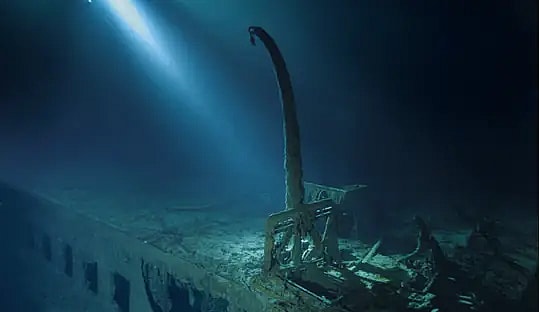
The Titanic’s lifeboat davits are crucial pieces of the ship’s safety equipment, and among them, the davit from Lifeboat A stands out for its historical significance among Titanic artifacts. Lifeboat A was one of the first lifeboats to be launched during the Titanic’s emergency, and its davit was recovered from the wreck site in the early 1980s. The davit’s retrieval provided valuable insights into the ship’s safety protocols and the challenges faced during the evacuation.
The davit, a large, robust piece of metal used to lower lifeboats into the water, is an essential artifact for understanding the Titanic’s emergency response system. The ship was equipped with a total of 20 lifeboats, which were not sufficient to accommodate all passengers, a fact that became tragically evident during the disaster. Lifeboat A, with its associated davit, was launched in the midst of chaos, and its recovery shed light on the operational aspects of the Titanic’s lifeboat deployment among Titanic artifacts.
The davit’s condition, marked by rust and wear, tells a story of the urgency and difficulty involved in the evacuation process. The Titanic’s lifeboat davits were designed to be strong and reliable, but the hurried and disorganized nature of the evacuation highlighted the limitations of the ship’s safety measures. The discovery of Lifeboat A’s davit offers a tangible connection to the frantic efforts to save lives amidst the disaster, illustrating the challenges faced by the crew and passengers in their desperate bid to escape.
Furthermore, the lifeboat davit is a symbol of the ship’s design flaws and the limitations of maritime safety standards at the time as one of the most interesting Titanic artifacts. Its recovery has contributed to a better understanding of the Titanic’s emergency procedures and has informed improvements in lifeboat and evacuation protocols in subsequent years. The davit’s story is a critical part of the Titanic’s legacy, reflecting both the heroic efforts and the tragic shortcomings of the ship’s response to its ultimate crisis.
Also Read: 18 Top Vintage Things Worth Money
8. The Captain’s Mug

Captain Edward Smith, the commanding officer of the Titanic, is a central figure in the ship’s narrative, and his personal belongings offer a glimpse into his life and leadership. Among the artifacts recovered from the wreck site is the Captain’s Mug, a silver piece engraved with the Titanic’s name. One of the most shocking Titanic artifacts, it provides insight into the daily life of the ship’s captain and his role during the disaster.
The Captain’s Mug, used by Smith for his beverages, was found in the captain’s quarters, preserved amidst the wreckage. It is a simple yet significant item, reflecting the captain’s presence and routine on the ship. The mug’s silver material and engraved details illustrate the Titanic’s luxurious accommodations and the personal touches that were part of the ship’s design among Titanic artifacts.
Captain Smith, a seasoned mariner with decades of experience, was known for his dedication and calm demeanor. His decision to stay with the ship during the disaster and his reported actions to ensure the safety of passengers reflect his commitment and leadership. The mug serves as a personal reminder of Smith’s role and the gravity of his final moments.
The Captain’s Mug is more than just a piece of silverware among Titanic artifacts; it represents the human element of the Titanic’s story. It provides a connection to the captain who went down with his ship, embodying the sense of duty and responsibility that defined his career. The mug’s presence among the wreckage underscores the personal losses and sacrifices made during the Titanic’s final hours, adding depth to the narrative of the ship’s tragic end.
7. The Wooden Deck Chair
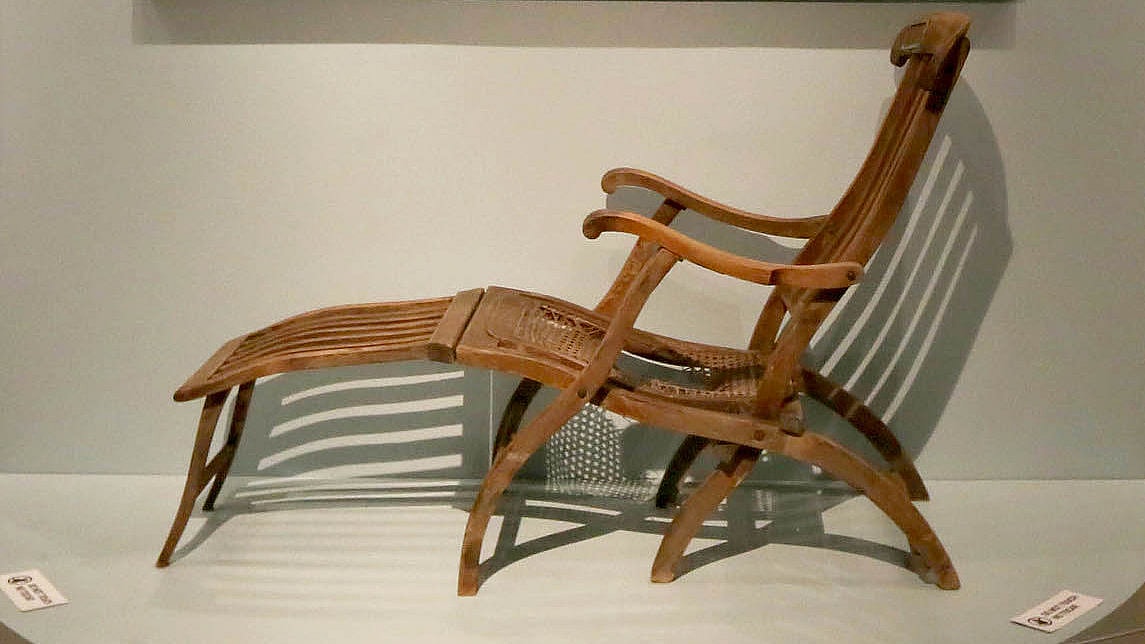
The Titanic was renowned for its luxury and attention to detail, and the wooden deck chair recovered from the wreck site is a testament to the ship’s opulent amenities among Titanic artifacts. Deck chairs were an integral part of the Titanic’s outdoor spaces, providing passengers with comfortable seating as they enjoyed the ocean views.
The wooden deck chair, found in the debris field, is notable for its craftsmanship and the quality of materials used as one of the rarest Titanic artifacts. Made from sturdy wood and upholstered with durable fabric, the chair reflects the Titanic’s commitment to providing a high level of comfort and style. The chair’s preservation allows us to visualize the elegance of the ship’s design and the luxury enjoyed by its passengers among Titanic artifacts.
The deck chair’s recovery is significant because it represents the everyday aspects of life aboard the Titanic. It serves as a reminder of the ship’s grandeur and the comfort that was part of the passenger experience of Titanic artifacts. The chair’s presence among the wreckage contrasts with the tragedy of the sinking, highlighting the loss of both luxury and life.
Additionally, the wooden deck chair symbolizes the Titanic’s attention to detail and the level of care taken in designing the ship’s accommodations. Its recovery provides a tangible connection to the opulence of the Titanic, offering insights into the luxurious lifestyle that was lost when the ship went down. The chair is a poignant artifact that reflects both the beauty and the tragedy of the Titanic’s final moments.
Read More: 12 Most Expensive Hotels in Venice
6. The Murdoch Family Bible

The Murdoch Family Bible is a deeply personal artifact that offers a glimpse into the life of one of the key Titanic artifacts. The Bible belonged to First Officer William Murdoch, who played a significant role in the ship’s operations and ultimately perished in the disaster.
The Bible was recovered from the Titanic’s wreck site and is a poignant reminder of Murdoch’s personal life and faith as Titanic artifacts. As a religious artifact, it provides insight into the spiritual beliefs of those aboard the ship. Murdoch, known for his professionalism and dedication, was among the many passengers and crew who faced the disaster with courage and resolve.
The recovery of the Murdoch Family Bible is significant because it highlights the personal and emotional dimensions of the Titanic tragedy. The Bible’s presence among the wreckage underscores the human aspects of the disaster, offering a connection to Murdoch’s personal beliefs and values. It serves as a reminder of the faith and resilience that characterized many of those who faced the sinking of the Titanic.
The Bible’s story is intertwined with Murdoch’s legacy and the broader narrative of the Titanic disaster. It reflects the spiritual and personal dimensions of the tragedy, adding depth to our understanding of the individual experiences and Titanic artifacts that occurred. The Murdoch Family Bible is a powerful artifact that enriches the Titanic’s legacy and honors the memory of those who were affected by the disaster.
5. The Titanic’s Silverware
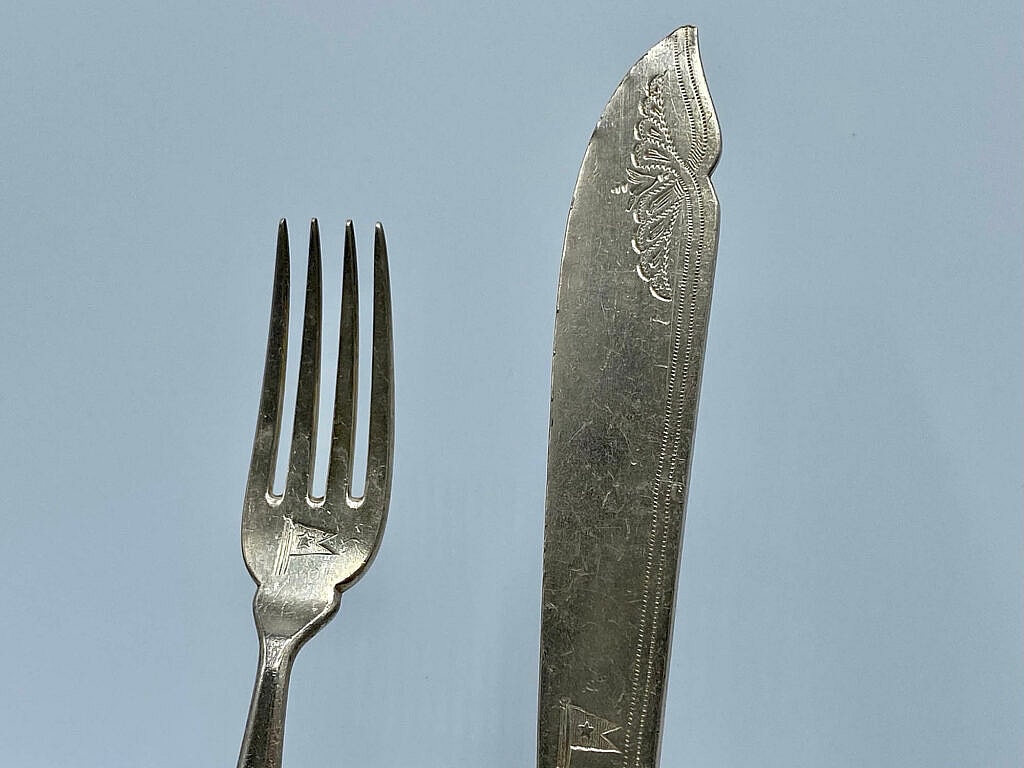
The Titanic’s first-class dining experience was renowned for its luxury, and the silverware recovered from the wreck site is a testament to the opulence of the ship’s accommodations among Titanic artifacts. The silverware, including forks, knives, and spoons, was part of the elaborate table settings used in the ship’s dining rooms.
Each piece of silverware, intricately designed and bearing the Titanic’s monogram, reflects the high standards of dining and service that were part of the Titanic’s reputation. The silverware’s craftsmanship and design highlight the attention to detail and luxury that characterized the ship’s first-class experience.
The recovery of the Titanic’s silverware is significant because it provides a tangible connection to the ship’s dining practices and the lavish lifestyle enjoyed by its passengers. The artifacts offer insights into the culinary and social aspects of life aboard the Titanic, illustrating the grandeur and refinement that were integral to the ship’s identity.
The silverware also serves as a symbol of the Titanic’s opulence and the loss of luxury that occurred with the ship’s sinking. The contrast between the ship’s elegance and the tragedy of its final moments is highlighted by these artifacts, which stand as a testament to the high standards and lavish amenities that defined the Titanic’s first-class experience.
4. The Life Jacket of Sidney Leslie Goodwin

The life jacket of Sidney Leslie Goodwin, a young boy who perished in the Titanic disaster, is one of the deeply moving Titanic artifacts that underscores the personal impact of the tragedy. Goodwin, traveling with his family, was among the many lives lost in the disaster, and his life jacket is a poignant reminder of the innocent victims of the Titanic’s sinking.
The life jacket, found among the wreckage, bears the name “Sidney Goodwin” stenciled on it, adding a personal touch to the artifact. Its recovery highlights the human cost of the disaster and the profound impact it had on individual lives and families. The jacket serves as a tangible connection to the young boy and his tragic fate, offering a somber reflection on the loss of life during the Titanic’s final hours.
Sidney Goodwin’s life jacket is a symbol of the many young lives affected by the disaster. It adds a deeply emotional layer to the Titanic’s story, reminding us of the innocence and vulnerability of those who perished. The Titanic artifacts serve as a tribute to the countless individuals whose stories are intertwined with the Titanic’s legacy, ensuring that their memories are honored and remembered.
The life jacket’s story is a powerful reminder of the human side of the Titanic disaster. It provides a glimpse into the personal tragedies and losses that occurred during the ship’s sinking, adding depth to our understanding of the disaster and its impact on those who were affected.
Also Read: Weird Songs: Did You Know the History Behind These 14 Weird Songs?
3. The Titanic’s Brass Bell
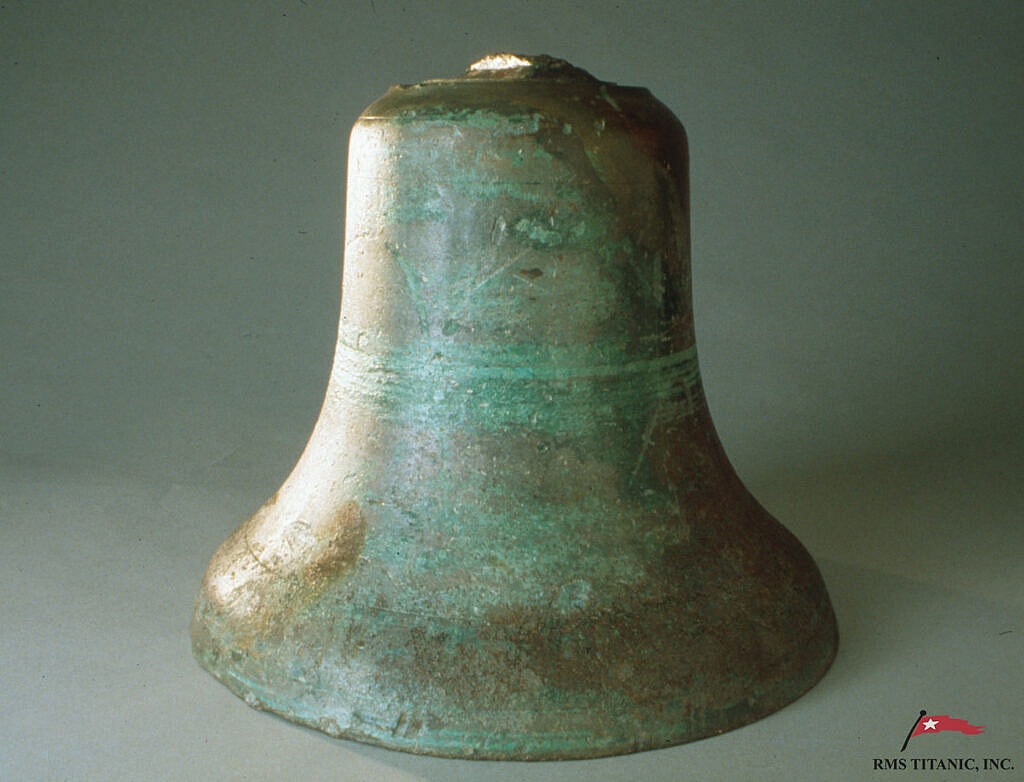
The Titanic’s brass bell is among important Titanic artifacts that offers insights into the ship’s operational aspects and communication systems. The bell, used for signaling on the ship, was mounted on the bridge and played a crucial role in managing the ship’s daily functions and communications.
Recovered from the wreck site, the brass bell is a testament to the Titanic’s maritime heritage and the technology used to operate the ship. Its detailed craftsmanship and engraved markings reflect the ship’s attention to detail and the high standards of its design.
The bell’s recovery is significant because it provides a tangible connection to the ship’s operations and the challenges faced by the crew during the disaster. The Titanic’s communication and signaling systems were critical to managing the ship’s emergency response, and the brass bell serves as a symbol of the efforts made to navigate and manage the crisis.
The brass bell is also a reminder of the ship’s technological sophistication and the limitations faced during the disaster. Its presence among the wreckage highlights both the advances in maritime technology and the difficulties encountered in the Titanic’s final hours. The Titanic artifacts stand as a testament to the ship’s design and the resilience of those who attempted to manage the crisis.
2. The Titanic’s First-Class Menu
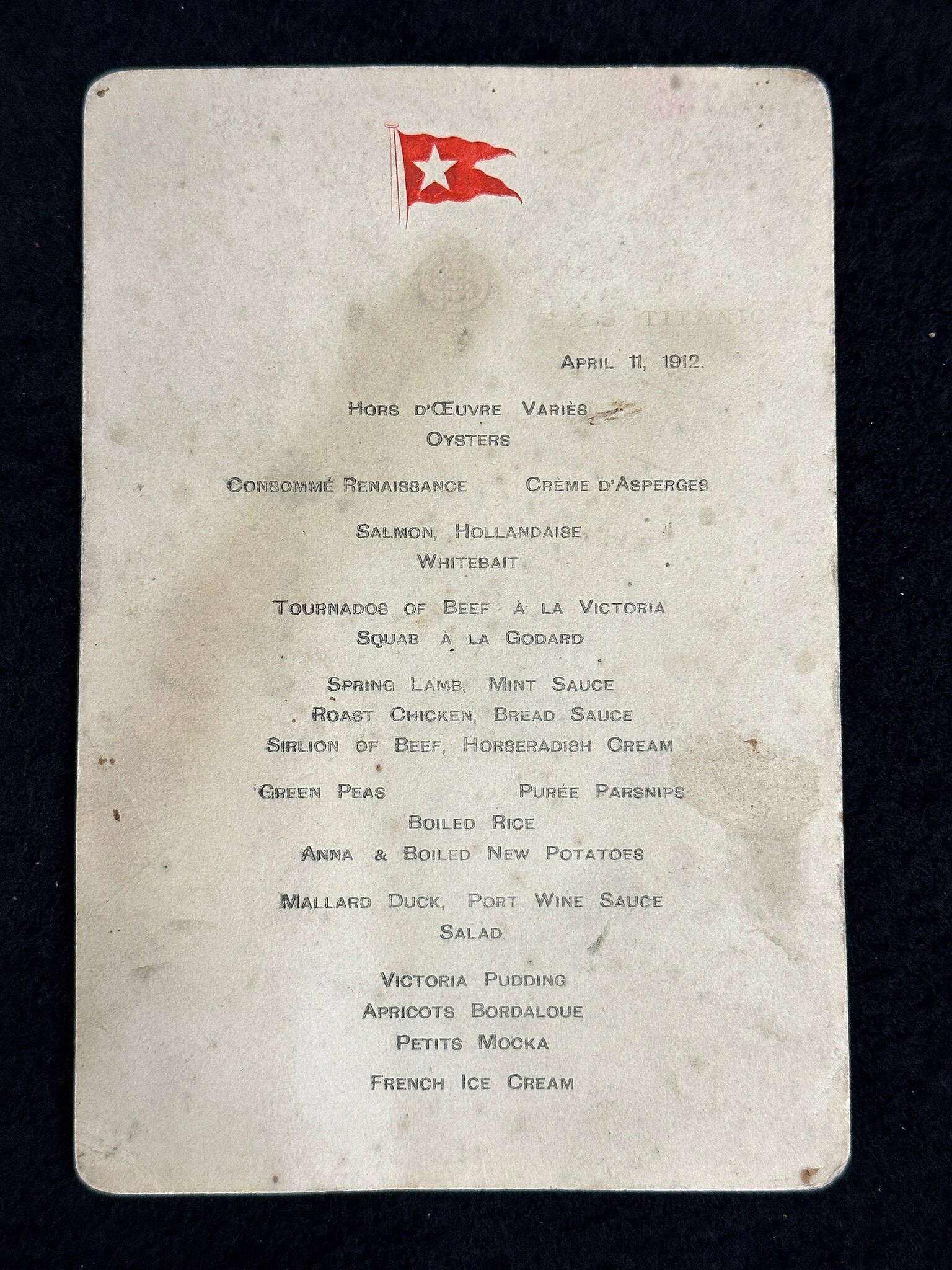
The Titanic’s first-class menu offers a detailed glimpse into the luxurious dining experience aboard the ship. The menu, recovered from the wreck site, features a variety of gourmet dishes that reflect the high standards of cuisine and service provided to the ship’s elite passengers.
The menu includes items such as caviar, lobster, and a range of other delicacies, highlighting the opulence and refinement of the Titanic’s dining experience. The artifacts provide insight into the culinary practices and preferences of the ship’s passengers, illustrating the lavish lifestyle enjoyed by those in first class.
The recovery of the Titanic’s first-class menu is significant because it offers a tangible connection to the ship’s social and culinary aspects among Titanic artifacts. The menu serves as a powerful reminder of the luxury that characterized the Titanic, contrasting with the tragedy of its sinking. It provides a glimpse into the grandeur of the ship’s accommodations and the high standards of service that were part of the passenger experience.
The menu’s story is intertwined with the Titanic’s legacy, reflecting both the elegance and the loss associated with the disaster. It serves as a symbol of the ship’s opulence and the sophisticated amenities that were lost when the vessel went down. The first-class menu is a poignant artifact that highlights the contrast between the Titanic’s luxury and the tragedy of its final moments.
Read More: 12 Best VR Games and How to Play Them
1. The Titanic’s Dressed-Up Dog Collar – Titanic Artifacts
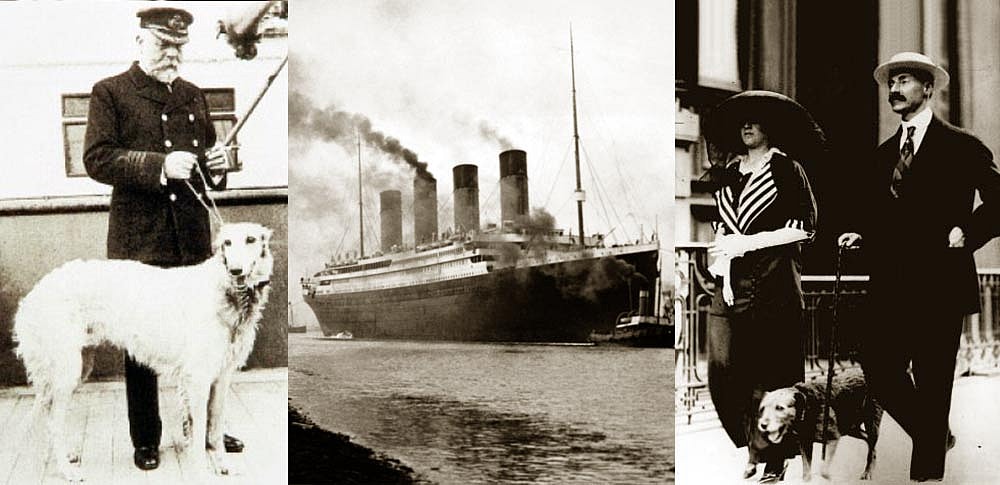
The Titanic’s dressed-up dog collar is one of the rare and intriguing Titanic artifacts that offers a unique perspective on the lives of passengers aboard the ship. The collar, adorned with fine materials and intricate design, belonged to a small dog that was among the pets traveling on the Titanic.
The collar’s discovery is significant because it highlights the personal and intimate aspects of life aboard the ship. Pets were an important part of many passengers’ lives, and the collar serves as a poignant reminder of the affection and care extended to animals during the voyage. The Titanic artifacts provide a glimpse into the social environment of the Titanic, where even pets were given a place in the luxury and comfort of the ship.
The dressed-up dog collar underscores the human connections and personal stories that are often overshadowed by the broader narrative of the Titanic’s disaster. It reflects the love and care that passengers had for their pets, adding a deeply emotional layer to the ship’s story. The collar’s recovery offers a tangible link to the lives and relationships that were part of the Titanic’s experience, highlighting the personal losses and tragedies that occurred during the disaster.
The collar’s story enriches the Titanic’s legacy, providing a unique and personal perspective on the ship’s voyage. It serves as a reminder of the everyday lives and connections that were affected by the disaster, ensuring that the memories of those who sailed on the Titanic, including their beloved pets, continue to be remembered and honored.
The Titanic artifacts recovered from the Titanic offer a profound connection to the ship’s ill-fated voyage and the lives it touched. Each item, from the pocket watch of Benjamin Guggenheim to the dressed-up dog collar, tells a unique story and provides a tangible link to the past. These Titanic artifacts not only enhance our understanding of the Titanic but also humanize the tragedy, reminding us of the individual experiences and personal losses that occurred.
As we explore these ten rare Titanic artifacts, we gain insight into the grandeur and tragedy of the ship’s final moments. They serve as enduring symbols of the Titanic’s legacy, preserving the memories of those who sailed on the ill-fated vessel and ensuring that their stories continue to resonate through time. Through these Titanic artifacts, we are reminded of the human element behind the Titanic’s grand narrative, and the importance of remembering and honoring the lives that were forever changed by the ship’s tragic end.


